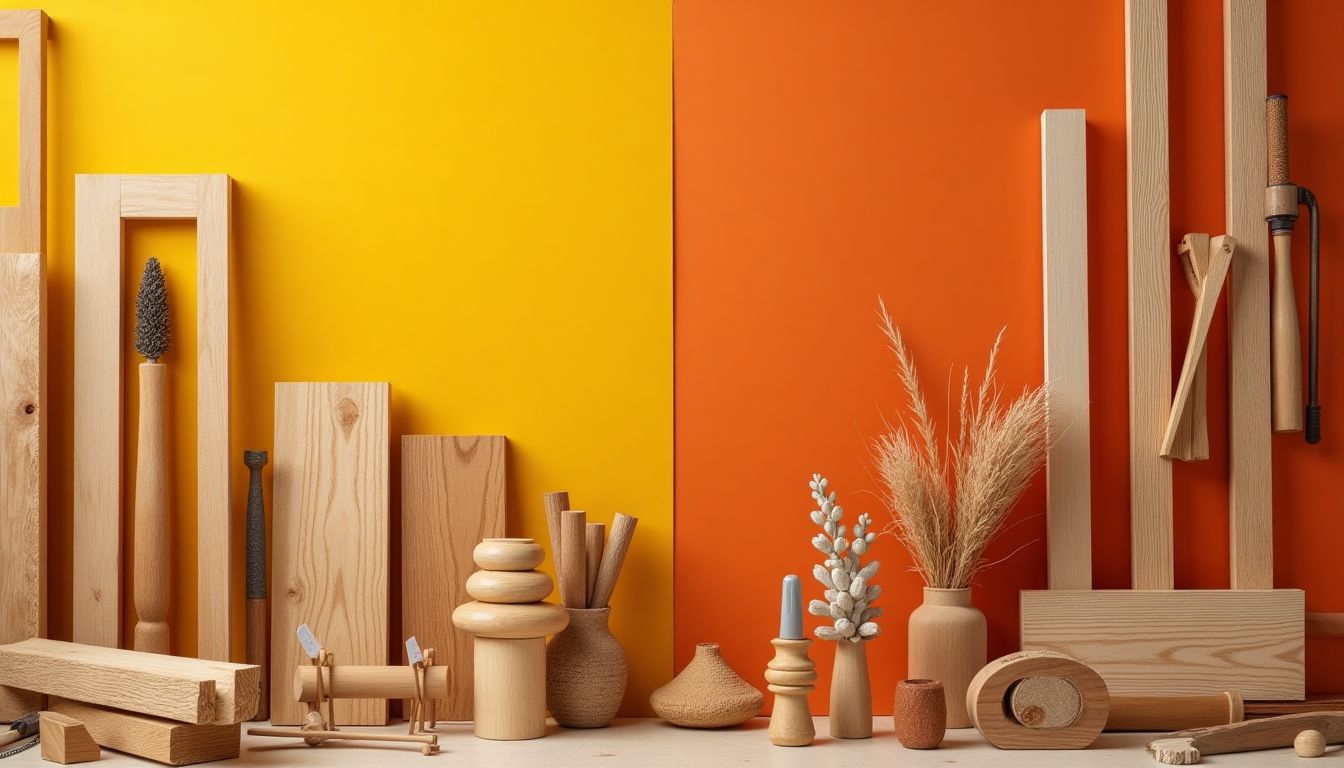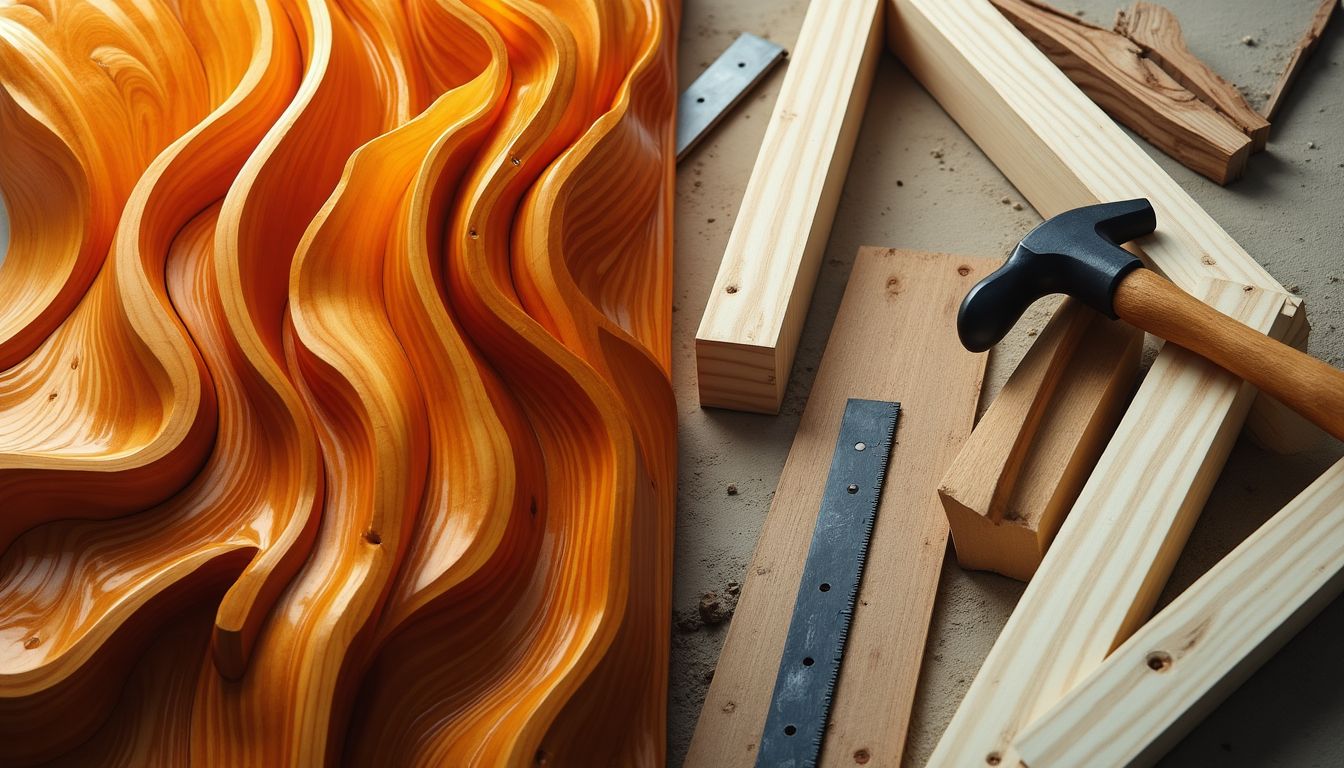Wood has been the silent hero of human civilization, shaping our homes, our tools, and even our art. From the intricate carvings of the Renaissance to the sturdy frames of modern skyscrapers, woodworking and carpentry have been the backbone of progress. But here’s the twist: while these two crafts are often lumped together, they’re as different as a hand-carved rocking chair and a house frame. So, what’s the real difference between woodworking and carpentry? And why does it matter?
Legendary woodworker George Nakashima once said, “The wood has a soul, and it speaks to those who listen.” His words capture the essence of woodworking—a craft that’s as much about artistry as it is about function. On the other hand, carpentry, as championed by figures like Norm Abram of This Old House, is the unsung hero of construction, turning raw materials into the bones of our homes. Even researchers like John Ruskin, who wrote extensively on craftsmanship, have debated the nuances of these disciplines. So, whether you’re a beginner dreaming of crafting your first coffee table or building a backyard deck, understanding the difference is your first step to mastery.
This article is your ultimate guide to unraveling the mysteries of woodworking and carpentry. We’ll explore their definitions, tools, skills, and real-world applications, helping you decide which path suits your interests. Plus, we’ll dive into how AI is revolutionizing both fields, making it easier than ever to get started. Ready to carve out your future? Let’s begin.
1. Definitions and Core Objectives
1.1 What is Woodworking?
Woodworking is the art of turning wood into something beautiful, functional, or both. Think of it as the creative cousin of carpentry. It’s where precision meets passion, and every cut, carve, and finish tells a story. From hand-carved chairs to custom cabinets, woodworking is all about craftsmanship and aesthetics. It’s the reason your grandmother’s antique dresser feels like a treasure, not just a piece of furniture.
Famous woodworkers like Sam Maloof have elevated the craft to an art form, creating pieces that are as much about beauty as they are about utility. If you’ve ever marveled at a wooden sculpture or a meticulously crafted jewelry box, you’ve witnessed the magic of woodworking.
1.2 What is Carpentry?
Carpentry, on the other hand, is the backbone of construction. It’s the discipline that turns blueprints into reality, framing houses, building decks, and installing doors and windows. While woodworking is about the details, carpentry is about the big picture—literally. It’s the reason your house stands upright and your roof doesn’t collapse during a storm.
Take Norm Abram, the beloved carpenter from This Old House. His work isn’t just about building; it’s about creating structures that last for generations. Carpentry is the unsung hero of the construction world, and without it, we’d all be living in tents.
1.3 Key Differences in Objectives
So, what sets these two apart? Woodworking is about artistry and precision. It’s for those who want to create something unique, something that tells a story. Carpentry, meanwhile, is about functionality and durability. It’s for those who want to build something that stands the test of time—literally.
Think of it this way: if woodworking is the poet, carpentry is the engineer. One crafts with emotion, the other with logic. Both are essential, but they serve very different purposes. And understanding that difference is the first step to choosing the right path for your woodworking journey.
2. Tools and Equipment
2.1 Tools Used in Woodworking
Woodworking is all about precision and artistry, and the tools reflect that. If you’re just starting out, you’ll need a mix of hand tools and power tools. Hand tools like chisels, hand planes, and carving knives are essential for detailed work. These are the tools that let you shape wood into something beautiful, like a hand-carved chair or a custom jewelry box.
Power tools, on the other hand, are the workhorses of woodworking. A table saw is a must for cutting large pieces of wood, while a router helps you create intricate edges and designs. And let’s not forget the random orbit sander—your best friend for getting that smooth, polished finish.
For those who want to get fancy, specialty tools like lathes and scroll saws open up a whole new world of possibilities. Imagine turning a block of wood into a delicate vase or cutting out intricate patterns for a wooden clock. The sky’s the limit!
2.2 Tools Used in Carpentry
Carpentry is more about building structures than creating art, so the tools are a bit different. Hand tools like hammers, levels, and squares are your go-to for measuring, aligning, and securing materials. These are the tools that ensure your walls are straight and your floors are level—because nobody wants a crooked house!
Power tools are just as important in carpentry. A circular saw is perfect for cutting lumber, while a nail gun speeds up the process of framing a wall. And if you’re working on a big project, like building a deck, a framing nailer will save you a ton of time and effort.
For heavy-duty tasks, carpenters rely on equipment like concrete saws and jackhammers. These aren’t your everyday tools, but when you need them, they’re worth their weight in gold.
2.3 Overlapping Tools
While woodworking and carpentry have their own unique tools, there’s some overlap. For example, both woodworkers and carpenters use drills and jigsaws. The difference is in how they’re used. A woodworker might use a drill to create precise holes for dowels, while a carpenter might use it to secure framing lumber.
Another example is the miter saw. Woodworkers use it to make precise angled cuts for picture frames, while carpenters use it to cut trim and molding. It’s the same tool, but the application is different.
So, whether you’re a woodworker or a carpenter, having a versatile set of tools is key. And if you’re just starting out, don’t worry—you don’t need to buy everything at once. Start with the basics and build your collection as you go.
3. Skills and Techniques
3.1 Woodworking Skills
Woodworking is as much about skill as it is about tools. Precision is the name of the game. Whether you’re cutting, joining, or finishing, every step requires attention to detail. For example, joinery techniques like dovetails and mortise-and-tenon joints are essential for creating strong, durable furniture.
Finishing techniques are another important skill. Staining, varnishing, and polishing not only protect the wood but also enhance its natural beauty. And let’s not forget about design. A good woodworker knows how to turn a simple piece of wood into a work of art. Whether it’s a hand-carved chair or a custom cabinet, the design is what sets it apart.
Artistic skills are also a big part of woodworking. Carving, inlay work, and marquetry require a steady hand and a creative eye. These are the skills that turn a functional piece of furniture into a masterpiece.
3.2 Carpentry Skills
Carpentry, on the other hand, is all about building structures. Framing, measuring, and leveling are the core skills every carpenter needs. Whether you’re building a house or installing a door, these skills ensure that everything is square, level, and secure.
Structural knowledge is also important. A carpenter needs to understand load-bearing calculations and building codes to ensure that a structure is safe and stable. This is especially important for large projects like framing a house or building a deck.
Another key skill is problem-solving. Carpentry often involves working with less-than-perfect materials or dealing with unexpected challenges. A good carpenter knows how to adapt and find solutions on the fly.
3.3 Skill Overlap
While woodworking and carpentry require different skills, there’s some overlap. Both involve measuring, cutting, and assembling wood. The difference is in the focus. Woodworkers focus on precision and aesthetics, while carpenters focus on functionality and structural integrity.
For example, both woodworkers and carpenters need to know how to use a saw. But a woodworker might use a band saw to make intricate cuts, while a carpenter might use a circular saw to cut lumber for framing.
Similarly, both woodworkers and carpenters need to know how to use a drill. But a woodworker might use it to create precise holes for dowels, while a carpenter might use it to secure framing lumber.
So, whether you’re a woodworker or a carpenter, developing a strong set of skills is essential. And the good news is, many of these skills can be learned through practice and experience. So, grab your tools and start building!
4. Applications and Projects
4.1 Woodworking Projects
Woodworking is all about creating beautiful, functional, and often artistic pieces. Whether you're crafting a custom dining table or carving a wooden sculpture, the possibilities are endless. Here are some common woodworking projects:
- Furniture: Tables, chairs, cabinets, and bookshelves are staples of woodworking. These pieces often require precision and attention to detail to ensure they are both functional and aesthetically pleasing.
- Decorative Items: Picture frames, wooden toys, and sculptures allow woodworkers to showcase their creativity. These projects are perfect for beginners looking to practice their skills on smaller, less complex items.
- Custom Pieces: From intricate jewelry boxes to hand-carved headboards, custom woodworking projects let you create one-of-a-kind items tailored to your taste or a client's needs.
For example, a handcrafted dining table isn't just a piece of furniture—it's a centerpiece that tells a story. If you're looking for inspiration, check out Ted’s Woodworking, which offers thousands of detailed plans for projects like these.
4.2 Carpentry Projects
Carpentry, on the other hand, focuses on structural construction and building frameworks. It’s the backbone of construction, ensuring that buildings are safe, durable, and functional. Here are some typical carpentry projects:
- Construction: Framing houses, building roofs, and installing staircases are core tasks for carpenters. These projects require a deep understanding of structural integrity and building codes.
- Renovation: Replacing doors, windows, and flooring are common carpentry tasks in home improvement. These projects often involve working with existing structures, requiring adaptability and problem-solving skills.
- Outdoor Structures: Building decks, pergolas, and sheds are popular carpentry projects that combine functionality with aesthetic appeal.
For instance, building a house frame is a massive undertaking that requires precision and teamwork. It’s a far cry from the detailed artistry of woodworking but equally rewarding in its own right.
4.3 Real-World Examples
To better understand the differences, let’s look at two real-world examples:
| Project | Woodworking | Carpentry |
|---|---|---|
| Dining Table | A handcrafted dining table with intricate joinery and a polished finish. | Not applicable—this is purely a woodworking project. |
| House Frame | Not applicable—this is purely a carpentry project. | Building the wooden framework for a new home, ensuring it meets structural standards. |
These examples highlight how woodworking and carpentry serve different purposes, even though they both involve working with wood.
5. Career Paths and Opportunities
5.1 Woodworking Careers
If you’re drawn to the artistry and precision of woodworking, there are several career paths to explore:
- Furniture Maker: Create custom furniture for clients or sell your pieces through galleries and online platforms. This career allows you to combine creativity with craftsmanship.
- Artisan: Specialize in creating unique, handcrafted items like sculptures, carvings, or decorative pieces. This path is ideal for those who want to focus on artistic expression.
- Woodworking Instructor: Teach others the skills you’ve mastered by offering classes or creating online tutorials. Platforms like Udemy make it easy to share your knowledge with a global audience.
Many woodworkers also choose to work independently, selling their creations through platforms like Etsy or at local craft fairs.
5.2 Carpentry Careers
Carpentry offers a wide range of career opportunities, particularly in the construction industry:
- Construction Carpenter: Work on building sites, framing houses, and installing structural elements. This is a steady, in-demand job with opportunities for advancement.
- Framing Specialist: Focus on creating the wooden frameworks for buildings. This role requires a strong understanding of structural engineering and building codes.
- Renovation Expert: Help homeowners update and improve their properties by replacing doors, windows, and flooring. This career is perfect for those who enjoy problem-solving and working with their hands.
Many carpenters also work as independent contractors, offering their services to homeowners and businesses. This path provides flexibility and the potential for higher earnings.
5.3 Choosing the Right Path
Deciding between woodworking and carpentry depends on your interests, skills, and long-term goals. Here are some factors to consider:
- Interest in Art vs. Construction: Do you enjoy creating artistic pieces, or do you prefer building functional structures?
- Work Environment: Woodworking often takes place in a workshop, while carpentry involves working on construction sites or in clients’ homes.
- Long-Term Goals: Are you looking for a steady job in construction, or do you dream of running your own woodworking business?
If you’re still unsure, consider trying both disciplines through beginner projects. For woodworking, check out Ted’s Woodworking for detailed plans. For carpentry, start with simple projects like building a shelf or repairing a fence.
6. AI Solutions: How Would AI Tackle This Issue?
6.1 AI-Powered Skill Assessment
Imagine an AI tool that could analyze your interests, skills, and even your personality to recommend whether woodworking or carpentry is the right path for you. Companies like IBM Watson are already pioneering AI-driven skill assessments in other fields. By leveraging machine learning algorithms, such a tool could evaluate your dexterity, creativity, and problem-solving abilities, then suggest tailored learning paths. For instance, if you’re drawn to intricate designs and artistic expression, the AI might nudge you toward woodworking. If you prefer large-scale projects and structural challenges, carpentry could be your calling.
6.2 Virtual Training Platforms
Platforms like Ted’s Woodworking could integrate AI to offer personalized tutorials and project suggestions. Imagine logging into a virtual workshop where an AI mentor guides you through each step of building a coffee table or framing a wall. Using augmented reality (AR) and virtual reality (VR), you could practice cuts, joints, and finishes in a risk-free digital environment. Companies like Oculus are already making strides in immersive training, and woodworking could be the next frontier.
6.3 AI-Enhanced Design Tools
AI can revolutionize how we design woodworking and carpentry projects. Tools like Autodesk’s Fusion 360 already use AI to optimize designs for manufacturing. For woodworking, AI could generate custom project plans, suggest material-efficient cuts, and even predict how a piece will look after staining or varnishing. For carpentry, AI could calculate load-bearing capacities, ensuring structures are both safe and efficient. Imagine an AI that designs a custom bookshelf based on your room dimensions and style preferences, or a carpentry AI that ensures your deck can withstand a hurricane.
6.4 AI in Tool Selection
Choosing the right tools can be overwhelming for beginners. AI could simplify this process by recommending tools based on your project needs and skill level. For example, if you’re building a birdhouse, the AI might suggest a basic jigsaw and sandpaper. If you’re framing a house, it could recommend a high-powered circular saw and nail gun. By integrating affiliate links like Amazon’s tool selection, the AI could even streamline the purchasing process, ensuring you get the best tools for your budget.
6.5 AI-Driven Market Analysis
AI can also help woodworkers and carpenters identify lucrative niches and emerging trends. By analyzing data from platforms like Etsy and Houzz, AI could reveal what types of furniture or home renovations are in demand. For instance, if minimalist furniture is trending, the AI might suggest focusing on sleek, modern designs. If outdoor living spaces are popular, it could recommend specializing in deck building or pergola construction.
6.6 Action Schedule/Roadmap
Here’s a detailed roadmap to bring these AI solutions to life:
- Day 1: Research existing AI tools for skill assessment and design optimization. Collaborate with universities like MIT and Stanford to develop algorithms tailored to woodworking and carpentry.
- Week 1: Launch a pilot AI-powered training platform. Partner with Ted’s Woodworking to integrate AI-generated project plans and tutorials.
- Week 2: Develop AI tools for tool recommendations, integrating affiliate links like Amazon’s tool selection for seamless purchasing.
- Month 1: Test AI-enhanced design tools with beginner woodworkers and carpenters. Gather feedback to refine algorithms and improve user experience.
- Month 2: Expand the platform to include AR/VR training modules. Partner with Oculus to create immersive woodworking and carpentry simulations.
- Year 1: Launch a comprehensive AI platform for woodworking and carpentry education. Offer subscription-based access to personalized tutorials, project plans, and tool recommendations.
- Year 1.5: Establish partnerships with construction companies and furniture makers to integrate AI tools into their workflows. For example, collaborate with IKEA to optimize furniture designs for mass production.
- Year 2: Expand the platform globally, offering multilingual support and localized content. Use AI-driven market analysis to identify regional trends and opportunities.
Why the Future of Woodworking and Carpentry Lies in AI
As we stand on the brink of a new era, it’s clear that AI has the potential to transform woodworking and carpentry from traditional crafts into cutting-edge disciplines. By leveraging AI-powered skill assessments, virtual training platforms, and design tools, beginners can accelerate their learning and achieve professional-level results faster than ever before. AI can also democratize access to these crafts, making them accessible to people of all skill levels and backgrounds.
But the impact of AI goes beyond individual projects. By analyzing market trends and optimizing designs, AI can help woodworkers and carpenters tap into lucrative niches and build sustainable careers. Whether you’re crafting a hand-carved chair or framing a house, AI can be your guide, mentor, and partner in success.
So, what’s stopping you from embracing the future? Whether you’re a beginner looking to explore woodworking or a seasoned carpenter seeking to enhance your skills, the tools and resources are at your fingertips. Check out Ted’s Woodworking for detailed project plans or browse Amazon’s tool selection to get started. The future of woodworking and carpentry is here—will you be part of it?
What do you think about the role of AI in these crafts? Could it replace traditional skills, or will it enhance them? Share your thoughts in the comments below, and don’t forget to subscribe to our newsletter for more insights into the world of woodworking and carpentry. Become a permanent resident of iNthacity: the "Shining City on the Web" and join the conversation!
Frequently Asked Questions (FAQ)
Q1: Can I do both woodworking and carpentry?
Absolutely! Many professionals combine skills from both disciplines, especially in custom home building or furniture making. For example, a custom furniture maker might use carpentry skills to build a sturdy frame and woodworking techniques to add intricate details. If you're interested in exploring both, check out Ted’s Woodworking for detailed plans that blend both worlds.
Q2: Which is more profitable, woodworking or carpentry?
It depends on your niche and goals. Carpentry often offers steady income in construction, especially if you work with companies like Turner Construction or Bechtel. On the other hand, woodworking can be lucrative if you specialize in custom furniture or art. For example, artisans like Sam Maloof have built successful careers by creating unique, high-end pieces.
Q3: Do I need formal training to start?
Not necessarily! While formal training can help, many beginners learn through online resources like Ted’s Woodworking or hands-on practice. If you're looking for structured learning, consider courses from institutions like North Bennet Street School or online platforms like Skillshare.
Q4: What tools should I buy first?
Start with the basics! Here’s a quick list of essential tools for beginners:
- Saw: A good handsaw or circular saw for cutting wood.
- Hammer: For driving nails and assembling pieces.
- Drill: A power drill for making holes and driving screws.
You can find affordable starter kits on Amazon or at local hardware stores like Home Depot.
Q5: How can AI help me as a beginner?
AI is revolutionizing woodworking and carpentry! For example:
- Personalized Project Plans: Platforms like Ted’s Woodworking use AI to suggest projects based on your skill level.
- Tool Recommendations: AI can analyze your project needs and recommend the best tools, which you can purchase through our Amazon affiliate link.
- Virtual Training: AI-powered platforms like MasterClass offer step-by-step tutorials to help you learn faster.
Q6: What’s the difference between hand tools and power tools?
Hand tools, like chisels and hand planes, are great for precision work and smaller projects. Power tools, like table saws and drills, are faster and more efficient for larger tasks. For beginners, a mix of both is ideal. Check out our Amazon affiliate link for a curated list of beginner-friendly tools.
Q7: How do I choose the right wood for my project?
The type of wood you choose depends on your project. Here’s a quick guide:
| Project Type | Recommended Wood |
|---|---|
| Furniture | Oak, Maple, Cherry |
| Decorative Items | Pine, Cedar, Walnut |
| Structural Projects | Douglas Fir, Spruce |
For more detailed advice, explore resources like The Wood Database.
Q8: Can I make a living from woodworking or carpentry?
Yes, many people do! Whether you’re building custom furniture or working on construction sites, there’s a demand for skilled craftsmen. For inspiration, check out the work of renowned woodworkers like George Nakashima or carpentry companies like Andersen Windows.
Q9: What safety tips should I follow?
Safety is crucial! Here are some key tips:
- Always wear safety goggles and gloves.
- Keep your workspace clean and organized.
- Read the manual for every tool before use.
For more safety guidelines, visit the Occupational Safety and Health Administration (OSHA) website.
Q10: Where can I find inspiration for my projects?
Inspiration is everywhere! Here are some great places to start:
- Follow woodworking influencers on Instagram.
- Explore project ideas on Pinterest.
- Check out books like The Complete Book of Woodworking.
Wait! There's more...check out our gripping short story that continues the journey: The Last Carver
Disclaimer: This article may contain affiliate links. If you click on these links and make a purchase, we may receive a commission at no additional cost to you. Our recommendations and reviews are always independent and objective, aiming to provide you with the best information and resources.
Get Exclusive Stories, Photos, Art & Offers - Subscribe Today!





























Post Comment
You must be logged in to post a comment.